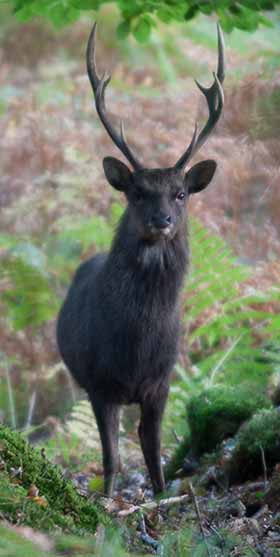New Forest mammals - an introduction

The New Forest is perhaps best known for its deer. Fallow deer, red deer and roe deer are fairly widespread and can often be seen; whilst sika deer are found in reasonable numbers, but generally only in the south of the area.
Muntjac deer are also present, but these tiny creatures are secretive and rarely seen, although their barking calls can sometimes be heard by those who regularly venture out into the woods.
Badgers are reasonably widely distributed, and so are foxes and rabbits, although in the New Forest, the latter occur at lower densities than in prime habitats elsewhere. (Perhaps surprisingly, animals of all three species often share the same tunnel system).
Grey squirrels are successful colonisers despite sometimes determined attempts by man to keep down their numbers. Sadly, however - as is now well-known - grey squirrels and red squirrels are unable to live together, and so when the grey squirrels arrived, the local red squirrels were driven out, could not compete for food or living space, or, more probably, fell victim to disease brought in by the interlopers.
Hedgehogs are scarce on the Crown lands of the New Forest - there is little suitable food for them - and hares are very rarely seen, probably for the same reason.
Mice, voles and shrews also occur only in modest numbers compared to many places elsewhere – heavy grazing by deer and commoners’ stock, and the consequent removal of ground level vegetation, does not suit them - and stoats and weasels are largely absent.
Bats of a variety of species, including the nationally rare Bechstein's and Barbastelle bats, are, however, present, sometimes in good numbers, but, of course, these flying mammals of the night skies are only likely to be seen or heard by enthusiasts out after dark.
Find out more about New Forest mammals
Quick linksMore links
Search this site

Sadly, 58 animals were killed - 35 ponies, 13 cows, 8 donkeys and 2 sheep, whilst a further 32 were injured - 3 pigs, 9 donkeys, 11 cows and 9 ponies.
(Forty-three accidents occurred in daylight, 15 at twilight and 101 in the dark. Twenty-seven accidents were not reported by the driver involved).
Here's just one horrific example - Three donkeys killed in collision with van at notorious New Forest blackspot (Advertiser and Times)
Sika deer continue to engage in rutting behaviour, and will do so until December.
Pigs seek out the remains of the acorn crop.
Beech leaves are transformed into a magnificent mosaic of glorious reds and golds. Other deciduous trees, too, take on an autumnal cloak before their leaves fall.
Dragonflies can occasionally be seen on the wing on bright days early in the month.
December
Foxglove leaves survive the winter at ground level, and offer the prospect of colourful summer blooms to come.
Redwings and fieldfares, autumn and winter visitors, gorge on haws and holly berries.
Great grey shrikes and hen harriers hunt over the heaths and other open spaces.
Honeysuckle by the end of the month often shows welcome signs of new growth.

